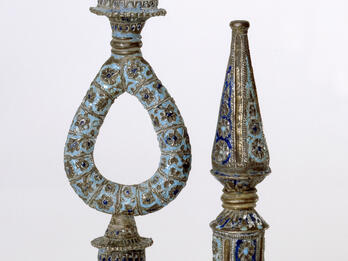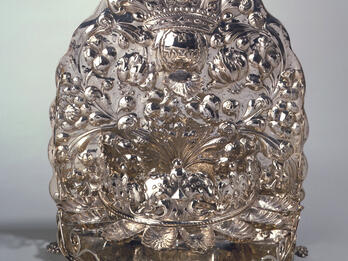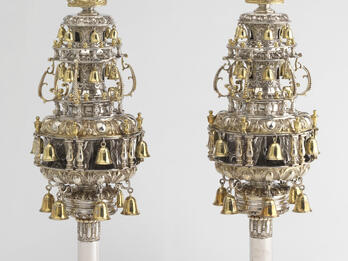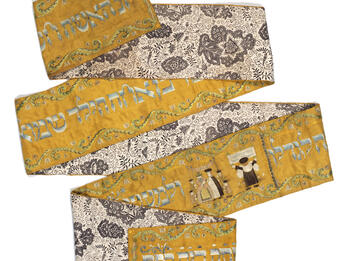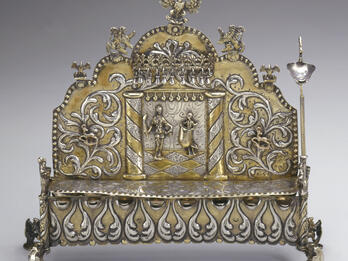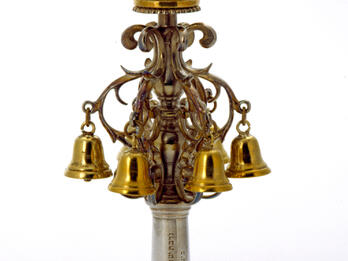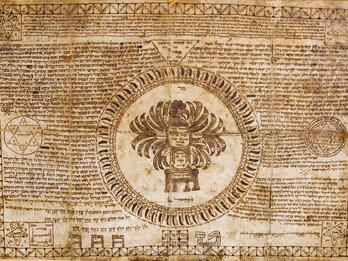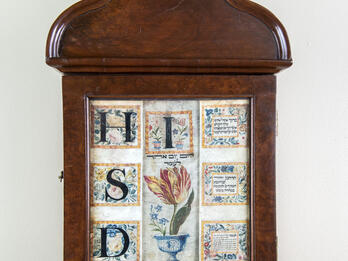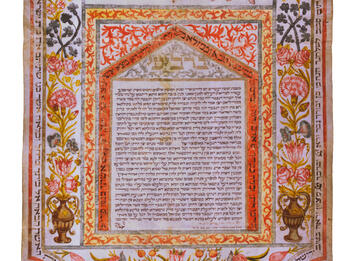Showing Results 31 - 40 of 83
Restricted
Image
These small Torah finials, decorated with silver repoussé and dark and light blue enamel, originated in Persia. They are further adorned with slender flowers and graceful geometric patterns.
Contributor:
Artist Unknown
Places:
Ottoman Empire (Iran)
Date:
18th Century
Subjects:
Categories:
Public Access
Image
This silver Hanukkah lamp, made in Amsterdam by the master silversmith Pieter van Hoven, sits on six claw legs and is decorated with intricate leaf and floral patterns. Its front side is further…
Contributor:
Pieter van Hoven
Places:
Amsterdam, Dutch Republic (Amsterdam, Netherlands)
Date:
1705
Subjects:
Categories:
Restricted
Image
These richly decorated Torah finials (rimonim), cast in silver and partly gilt, and adorned with many bells and topped with crowns, were created in London. The non-Jewish silversmith William Spackman…
Contributor:
William Spackman
Places:
London, Great Britain (London, United Kingdom)
Date:
1719
Subjects:
Categories:
Public Access
Image
This richly decorated Torah binder is thought to be from Rechnitz, based on its dedication as a gift from Gitl bat Samuel for Samuel ben Leib of Rechnitz in 1750. The Torah binder (also known as a…
Contributor:
Artist Unknown
Places:
Rechnitz, Habsburg Empire (Rechnitz, Austria)
Date:
1750
Subjects:
Categories:
Public Access
Image
At the center of the backplate of this Hanukkah lamp from Frankfurt am Main is a scene depicting the biblical heroine Judith, who has cut off Holofernes’s head and is about to place it in a sack held…
Contributor:
Johann Valentin Schüler
Places:
Frankfurt am Main, Holy Roman Empire (Frankfurt am Main, Germany)
Date:
Late 17th Century
Subjects:
Categories:
Public Access
Image
This belled gilt-silver Torah finial topped with a crown was made in Amsterdam and has been attributed to master silversmith Pieter van Hoven, who lived near the Jewish quarter and is best known for…
Contributor:
Pieter van Hoven
Places:
Amsterdam, Dutch Republic (Amsterdam, Netherlands)
Date:
1717
Categories:
Public Access
Image
Amulets were crafted to protect pregnant women and newborn children from the powers of the evil Lilith, Adam’s mythical first wife. Mystical texts surround this image, written in Hebrew, Aramaic, and…
Contributor:
Artist Unknown
Places:
Kingdom of Travancore (State of Kerala, India)
Date:
18th century
Categories:
Public Access
Image
This omer calendar, marking the days between the holidays of Passover and Shavuot, is still used at Congregation Mikveh Israel in Philadelphia. The letters stand for H=Homer (Ladino for Omer); S…
Contributor:
Artist Unknown
Places:
Philadelphia, United States of America
Date:
18th century
Subjects:
Categories:
Restricted
Image
The ketubah is a religious and legal contract of marriage. Traditionally, ketubot outline the conjugal and economic conditions of a marriage and are written in Aramaic. This ketubah was copied and…
Contributor:
Artist Unknown
Places:
Rome, Papal States (Rome, Italy)
Date:
1754
Subjects:
Categories:
Restricted
Image
This Biedermeier-style sofa from Danzig, with birch veneer over pine, may have been commissioned on the occasion of a marriage. The oval on the seat back contains an image of clasped hands, and the…
Contributor:
Artist Unknown
Places:
Danzig, Kingdom of Prussia (Gdańsk, Poland)
Date:
1838


